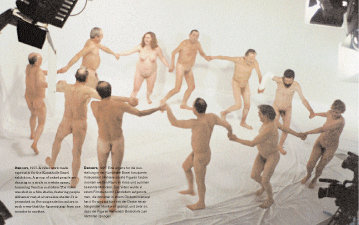Pawel Althamer
dal 12/9/2006 al 26/11/2006
Segnalato da
12/9/2006
Pawel Althamer
Centre Pompidou, Paris
Althamer assembled a group of eleven young artists from different art schools to work on a joint project, a filmed shadow-play in eleven episodes. Althamer himself contributes a film telling the story of the project. The exhibition is the fruit of this collaboration, a reflection on the status of the artist in a society dominated by the cult of celebrity.

With: Ce'line Ahond (France), Ziad Antar (Lebanon), Liliana Basarab (Romania),
Veaceslav Druta (Republic of Moldavia), Adriana Garcia Galan
(Columbia), Kapwani Kiwanga (Canada),Elise Mougin (France), Vincent Olinet
(France), Emilie Pitoiset (France), Koki Tanaka (Japan), Adam Vackar (Czech
Republic).
The Centre Pompidou presents in Espace 315 an exciting and distinctive project by
the Polish artist Pawel Althamer, exploring the role and place of the artist in
today's society.
For this Althamer assembled a group of eleven young artists from different art
schools to work on a joint project, a filmed shadow-play in eleven episodes.
Althamer himself contributes a film telling the story of the project. The exhibition
is the fruit of this collaboration, a reflection on the status of the artist in a
society dominated by the cult of celebrity.
Today Pawel Althamer defines his work according to three groups : works in relation
to the institution, those addressing groups or the notion of community, and those
associated with the family. He often plays on the notion of disappearance,
disappointing traditional expectations of the artist by working through substitutes.
He transforms an exhibition space into a waiting room, asks his daughter to
supervise his exhibition, or gives a guardian a radio and tea pot in order to make
her job more comfortable. His presence then is effaced, discrete. His propos are
veiled, mysterious and disquietingly subversive.v
The same principle is at play in this exhibition at the Centre Pompidou, involving
eleven young artists
Rejecting any idea of individual competition, the artists were chosen from a
preliminary list of twenty with a view to their forming a cohesive group. They were
then invited to participate in a number of workshops. Pawel Althamer again uses his
art as a means of opportunity for others, and offers the Centre Pompidou as a place
of possibility for young creation in order to allow them to develop their creativity
thanks to the tools proposed by the institution (collections, documentation,
audio-visual equipment, technicians, curators, publications etc.). His contribution
to the exhibition consists of a film tracing the project’s process and the group’s
different exchanges.
However, Pawel Althamer’s real interest lies in digging the grittier question of
what does it mean to form an artistic collective today, especially within the
context of an institutional exhibition. In concentrating purely on the process of
collaboration between these young artists, he puts to one side their individual
artworks and shifts the emphasis away from the idea of an artist star. Coming from a
variety of origins, practices and media, artists today no longer function according
to the more “romantic" mode of artistic groups. Is this notion outdated, or can it
be revived? Working with young artists allows Pawel Althamer to dialogue with a new
generation full of questions concerning their own future in a world which operates
according to the rules of competition and competitiveness. In the Centre Pompidou
therefore inverses a process such as that launched by Jeffrey Deitch in New York
with his project Artstar, which imitates a television reality show and aims to
highlight an artist star.
September, 14, 2006
Centre Pompidou
Place Georges Pompidou 01- Paris
Opening hours: The exhibition is open every day except Thuesdays from 11am to 9pm



